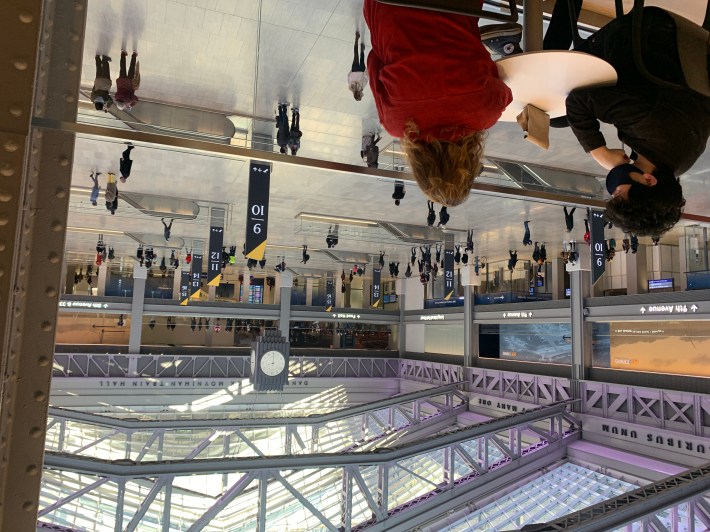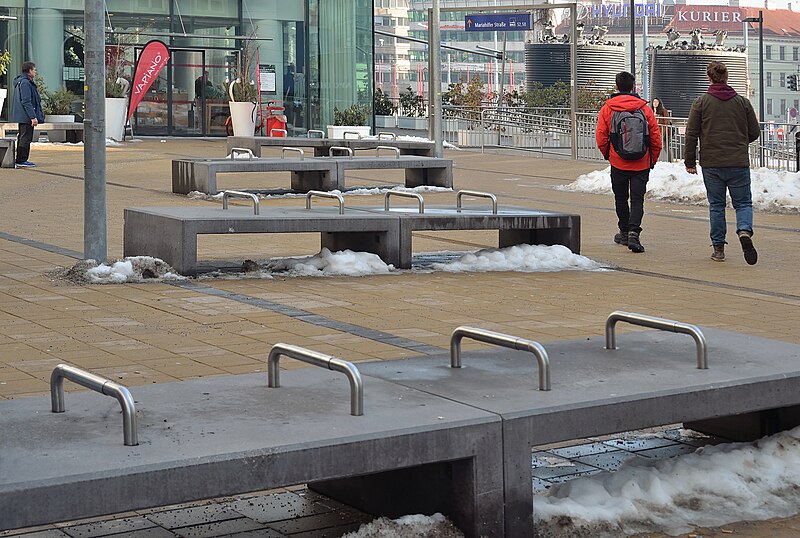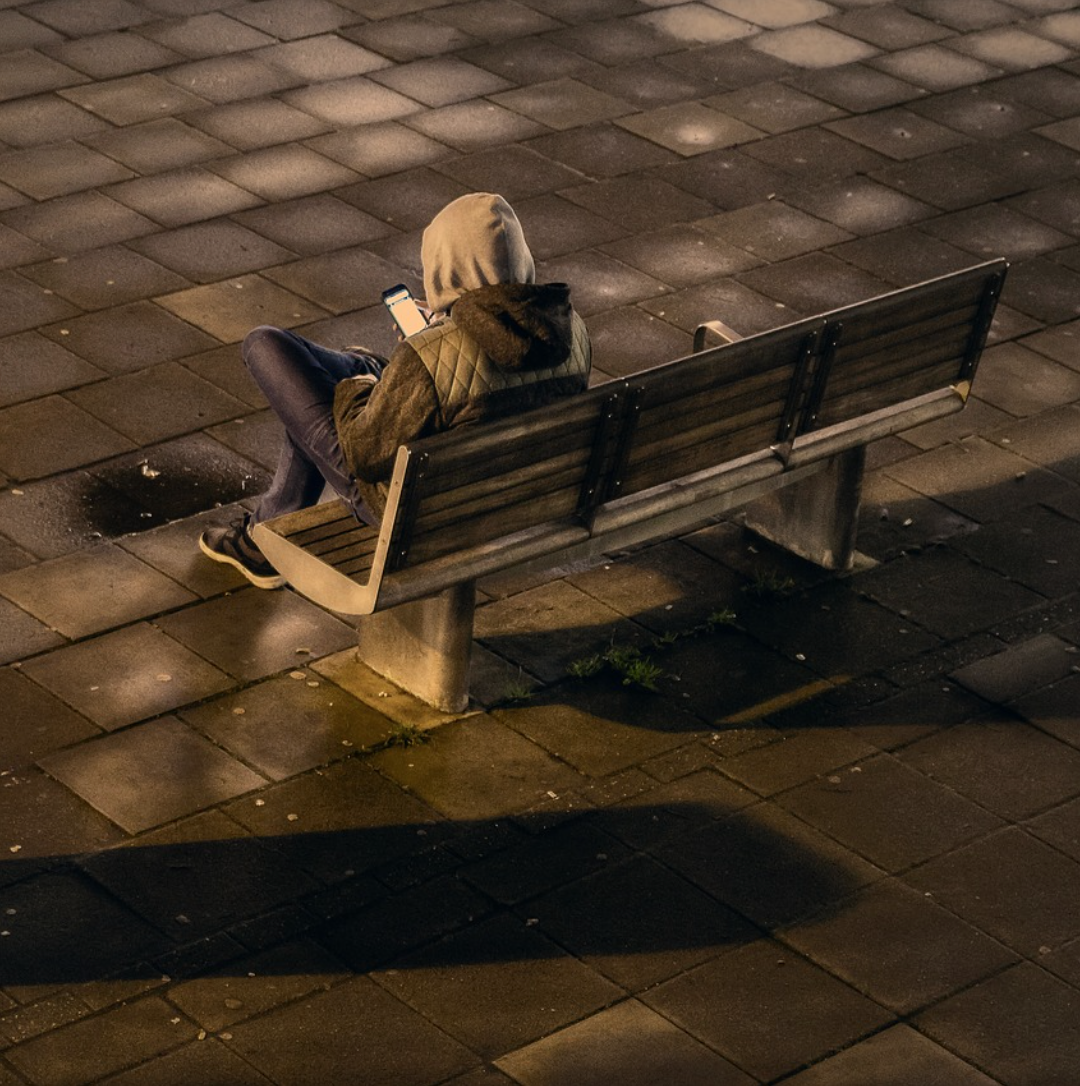When I met Ms. Mary, she was lying on the ground two blocks away from her bus stop, her hip broken in two places.
It was a stroke of sheer luck that I was even on that road. Taking Jefferson Avenue is the fastest way to get to my favorite neighborhood park, but unless I'm particularly bored of my usual jogging route, I try to avoid it, because it's a six-lane arterial with two highway on-ramps and notoriously short crosswalk signals. According to Ms. Mary, most of our neighbors avoid Jefferson, too: she had been lying there in the cold for about 20 minutes before I found her there, reaching desperately for a cell phone that had tumbled out of her purse and halfway down the grassy hill on the other side of the sidewalk. Ten feet away, drivers whizzed by, occasionally turning in to the strip mall parking lots that flanked the road, but no one stopped for her.
While I waited with her for the ambulance to arrive, Ms. Mary couldn't stop crying from the pain. But mostly, she said, she was crying because she was ashamed of herself: she was on a new medication that made her feel dizzy sometimes, she explained, and while she was walking the five long blocks home from her grocery store, she had suddenly felt unsteady on her feet and knew she needed to sit down, and fast.
"I thought there must be a bench somewhere," she said. "I was so silly. I thought I could find one in time, but then my feet just went out from under me. I should have known better."

I thought of Ms. Mary again this week when Twitter erupted in outrage at the lack of seating at the newly minted Moynihan Train Hall (aka the new Penn Station), save a handful of chic Scandi-style lounging areas reserved for ticket-holders — or, as Streetsblog NYC succinctly put it, "the exclusive domain of the Haves, not the Have Nots."
Like countless other sorry transit stops across America before it, Moynihan Train Hall seems to have been largely denuded of places to rest, the very architecture of the space all but demanding that that visitors pass the time by spending their cash in the station's adjacent restaurants and shops.
Ms. Mary probably wouldn't have fared terribly well if she'd had a dizzy spell there, either, but at least she probably would have gotten help from a bystander a little sooner than on the side of a car-centric road in the middle of one of St. Louis more populous neighborhoods.
I've never seen a train station without seating. Have you ever seen an airport without seating? This is just anti-human. https://t.co/3Es8WPcpCe
— noel hidalgo • 🗽❤️🔥🚲 (@noneck) January 1, 2021
When we talk about increasing access to sustainable transportation, many street safety advocates fail to talk about placing benches with anywhere near the fervor with which we talk laying train track or building bike lanes. Public seating is too often seen as a luxury: something to make the wait for a behind-schedule bus a little more tolerable, or to offer a pleasant respite during an afternoon stroll in a park. Attempt to assess the walkability of your neighborhood street using the AARP walk audit tools, and you won't even see the word "seating" mentioned until the 12th page — in the section labeled "comfort and appeal," sandwiched between questions about whether the street has flowers and if the landscaping is attractively maintained. It's a nice-to-have, sure, but it's not a page-one necessity.
But for countless people, comfortable public seating isn't just aesthetic: it's a matter of basic safety and essential dignity. And its absence in the transportation space sends a deliberate signal about who we welcome in the public realm, and who we don't.

The lack of public seating in the transportation realm, of course, is virtually indivisible from America's near-genocidal cruelty towards people who find themselves unhoused. The absence of a simple, inexpensive bench in a train station, is, at its heart, a physical reminder that our society views the movement of consumers and consumable goods as the primary purposes of our transportation spaces— and criminalizes those who dare to simply rest in our streets and stations, rather than moving through them on their way to make or spend money.
Of course, the simple absence of seating isn't the the only way that we inflict suffering on the unsheltered in our transportation realm. There's also the presence of so-called "defensive" design elements: think metal spikes on otherwise-leanable curbs, or dubious "arm rests" on park benches that prevent anyone from getting too comfortable for too long. And Explicitly "hostile architecture" is only the most obvious physical manifestation of the countless anti-homeless policies that have long provided legal sanction for police officers to arrest or assault anyone who seeks rest in an inconvenient place, even if their society provides them with no safe alternatives.
Since 2006, cities across America have passed at least 33 new laws strengthening centuries-old prohibitions against "loitering, loafing, or vagrancy" — vague terms that police officers largely have discretion to enforce at will. In New York, the MTA even suspended overnight subway service and restricted station access specifically "to clear out homeless folks" when night falls. Such policies are rarely accompanied by sufficient increases in funding to programs that would provide the unhoused with alternative places to rest.
“The installation of hostile architecture is a tactic that effectively announces that this is not our problem,” Ainslie Murray, senior lecturer in Architecture at UNSW Built Environment, said in a recent interview. “When you multiply this logic across many decisions, you’re left with a society that considers some of the biggest problems are for somebody else to solve.”
And then there are the horrifying extra-legal consequences of forcing the unhoused to move along from sheltered public spaces that might have helped protect them, or least allowed them a moment of respite. An estimated 1,769 people without access to adequate shelter were the victims of hate crimes in 2016 and 2017 alone, and countless others died from preventable illnesses that are often exacerbated by lack of access to basic shelter and spaces to rest.

For people with mobility challenges — like Ms. Mary, or literally any human being with a body that needs occasional rest — the absence of a safe place to sit on a street corner can lead to a devastating accident, or the loss of your basic freedom to navigate your immediate neighborhood at the speed your body needs.
And of course, for parents of small children, a lack of convenient neighborhood benches can render a simple neighborhood walk all but impossible — because God knows no one wants to carry a cranky, 40-pound 5-year-old all the way home just because it's hot and she's tired of walking and she needs a break to watch Paw Patrol on the iPad now.
Of course, not all public seating is created equal — nor is it all built with the people who need it most in mind. In 2015, Toronto-based advocate Gracen Johnson highlighted some of the worst examples of bad bench placement in an article series for Strong Towns, which went on to spawn a viral social media hashtag, #PlacesIDon'tWantToSit, and a one-woman campaign to "chair-bomb" strategic areas of her city with tree stumps that could be used as ersatz stools.
The entire campaign is a master class in the difference between comprehensively people-centered design, and the type of cursory, box-checking urbanism that gestures at building a great place but fails to actually consider the real needs of the people who might linger there.
In 2016, mental healthcare workers in Zimbabwe offered a particularly inspiring example of the power of good public seating with their Friendship Bench project, which provided comfortable places for residents to rest and set hours when crisis workers were available to sit with them and offer basic counseling, along with referrals to further services. The model eventually spread to 72 locations, and helped over 40,000 people access treatment and resources, all for the cost of a single, $1-million grant.
Whether it's staffed by path-breaking healthcare workers or not, good public seating is an essential ingredient of a truly great place — and when built right, it can help make walking, biking and transit an accessible option to more people. And considering the fact that we could build a bench and a rain shelter at every bus stop in America for roughly the cost of a single Texas highway project, we have no reason not to start now.
But until we get started, people like Ms. Mary will keep getting left behind. I got a call from her son the day after her accident — or more accurately, the day after our city failed to provide a basic safety amenity that could have saved her a trip to the ER and an injury that, he feared, would likely shorten her life. She was in good spirits, he told me, but she wasn't happy about having to give up her weekly bus trip to the store, which her doctor said she probably couldn't manage safely on her own anymore.
I still run Jefferson Avenue a few times a month, and I keep an eye out for her. But I never saw her at that bus stop again.






